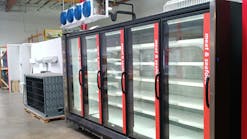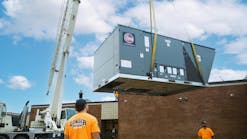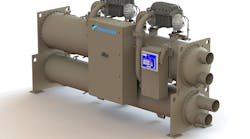Latest from Commercial HVAC
Applying the 'Internet of Things' to Create Smart Buildings
The Internet of Things (IoT) promises to create smart buildings by uniting disparate facility systems into an integrated whole. With the IoT it can be possible to manage and control temperatures, ventilation, lighting, access, parking, room occupancy, elevators and energy usage in a facility, either on-site or remotely.
IoT applications sound futuristic but many of them are available now. All building automation systems (BAS) contractors and integrators will be fielding questions and requests from customers about the IoT for buildings this year, so being prepared with thoughtful answers is essential.
The "Internet of Things" can be defined as a large number of data sending points brought into a cloud environment where analytics can be applied to influence outcomes.
IoT makes possible a variety of applications using connected devices and data driven decision support systems. The most beneficial of these provide predictive or
To begin, what is the IoT? In the context of building management applications, the IoT can be defined as a large number of data points brought into a cloud environment where analytics can be applied to influence outcomes.
IoT makes possible a variety of applications using connected devices and data driven decision support systems. The most beneficial of these provide predictive or pre-emptive knowledge of building or facility operating parameters outside the target zone. Examples include space temperatures above or below service level agreement values or energy consumption rates above targeted operating ranges. Using analytics to understand what’s happening in a building and then making appropriate corrections is probably the most important advance using IoT and smart building technology. This allows for quick resolution to issues and even makes it possible to take pre-emptive steps to resolve problems before they emerge. IoT technology can even be used as a method to continuously commission a facility.
Using analytics to understand what’s happening in a building and then making appropriate corrections is probably the most important advance using IoT and smart building technology.
As more articles and conferences focus attention on the concept of intelligent buildings and IoT, building owners are asking integrators to “make their building smart.” While an integrator could take advantage of this as an opening to start selling any number of advanced technologies, the better response is to find out what facility owners think a smart building is and understand their expectations. In the final analysis, using the IoT to create a smart building must add value to a business in order to be worthwhile. The application of smart building and IoT technology should accomplish three important things:
- Reduce costs
- Reduce risk
- Improve the occupant experience
Meeting all of these objectives ultimately adds value to a property through cost savings and enhanced revenue. When contractors can provide these to customers then the IoT technology they offer is delivering a measurable ROI.
The first step is to explore the facility operator’s specific goals for the building. These will vary based on the type and use of the facility.
The first step is to explore the facility operator’s specific goals for the building. These will vary based on the type and use of the facility. The goals for a hospital will be different than those of a university which will differ from those of a commercial office building. Whatever IoT and smart building technology is applied must drive outcomes that address business issues related to the specific facility. Just having technology doesn’t make a building smart – it must have the technology that supports the goals of the operator and occupants and there must be people in place to apply and use the technology effectively.
From a business perspective, owners are interested in improving customer experiences and processes, increasing a building’s operational effectiveness, and reduce energy consumption, all to meet the goal of optimizing the financial performance off the building. There are several innovations facility operators are looking for that can be delivered using IoT. One is greater flexibility in systems management, such as wireless system access via phone and tablet. There is also a desire to make more operational adjustments, including temperature adjustments, schedule overrides and intelligent sub metering, available to building occupants. Some facility operators believe applications such as personalized comfort control, dimmable lighting, and work space adaptation can contribute to higher workforce productivity and customer satisfaction. But in order for these applications to be available, there must be sensor points in place and mechanical systems zoned accordingly, so this level of connectivity is easier to apply in a new building than in a retrofit application.
Just having technology doesn’t make a building smart – it must have the technology that supports the goals of the operator and occupants and there must be people in place to apply and use the technology effectively.
When applying IoT technology it’s crucial to get all the stakeholders involved – the consultants, designers, installers, integrators, owners, renters, facility management, corporate IT — on the same page. The design and implementation has to be a joint effort with all parties because if one piece of the IoT puzzle is not implemented right, then parts of the building will not function.
The specifying stage is a crucial phase when integrating a building into the IoT. Don’t fall prey to a siloed procurement method whereby the various systems which would comprise the backbone of the building’s IoT are purchased separately with no overarching program management focused upon integrating the various systems in a comprehensive and durable fashion. Make sure that data from the various devices and systems in a building can be acquired and aggregated with the IoT applications. For the most part, building equipment is designed to operate in a fully automatic, totally self-contained fashion. This means that even if the specific piece of equipment includes a microprocessor for managing its internal functions, the data stream that would be of interest for inclusion in an overarching building analytics eco-system may not be easily accessible through common web interchange formats, such as XML or SQL. Frequently, liberating the interesting data from these systems becomes the work of a specialized systems integrator and involves some higher level protocol conversion and separate data storage server.
Network security is enormously important when integrating a building into the IoT because, unlike the traditional BAS that operates independently, the IoT relies on the corporate IT backbone.
Network security is enormously important when integrating a building into the IoT because, unlike the traditional BAS that operates independently, the IoT relies on the corporate IT backbone. Coordination and trust between the integrator, facility operations personnel and the IT staff is critical from day one. By working together, all parties can agree on standards for incorporating the IoT platform into the overall IT infrastructure. At a minimum, there should be firewalls, data encryption and authorization and authentication protocols in place.
Contractors and integrators will discover that servicing a smart building integrated into the IoT is a completely different experience than working on a conventional building. Using real-time 24/7 data shifts the focus from a reactive service model to one that is more preventative. For example, the IoT technology will be able to alert operators to changes that indicate a potential problem is coming before a system failure occurs. This allows technicians to pro-actively make repairs or adjustments in advance, rather than after occupants complain.
Finally, because the investment required to create a smart, IoT integrated building is high, make sure that solutions in place are scalable and adaptable. Be prepared to expand systems as new technologies emerge and operators request additional features and capabilities that have not even been considered today. Advancements in algorithms and analysis, new technologies for business and personal use – all of these will be coming in the future and integrators should prepare today’s smart buildings to develop into the intelligent buildings of tomorrow.
Leroy Walden is President of the InsideIQ Building Automation Alliance, an international alliance of independent building and facility automation companies representing common automation and security system platforms. Walden is also Vice President - technical Systems Sales, Automation and Control Solutions for Atlanta-based McKenney’s Inc., a leading systems integration and BAS contractor in the southeastern US.













